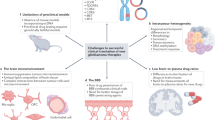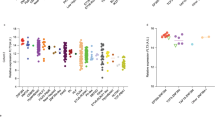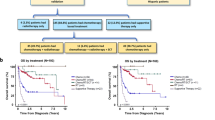Abstract
Predicting responsiveness to anticancer therapy based on molecular findings at diagnosis is important to optimize treatment decisions. Although clinical outcome correlates with distinct mutations in some cancer entities, treatment responses within these lesion-stratified subgroups still remain heterogeneous, underscoring the need for additional prognosticators. We previously demonstrated that defined genetic defects at the INK4a/ARF locus, which encodes the tumor suppressors p16INK4a and ARF, not only accelerated lymphomagenesis in the Eμ-myc transgenic mouse but also interfered with treatment sensitivity. In this study, we take a nonbiased genome-wide approach to examine whether the responsiveness of these lymphomas can be further stratified based on cytogenetic information at diagnosis. Indeed, using spectral karyotyping, comparative genomic hybridization, and fluorescence in situ hybridization in 38 primary lymphomas, we find recurrent cytogenetic alterations that refine the predictive value of INK4a/ARF lesions on drug responses in vivo: gain of chromosome 14, which was never detected in INK4a/ARFnull lymphomas, defined an ARFnull subgroup with superior treatment outcome. Gain of chromosome 6 was identified as a recurrent chromosomal aberration that predisposed ARFnull tumors to their subsequent INK4a loss during therapy. These data illustrate how cytogenetic information from cancer specimens might complement established prognostic markers and may improve anticancer treatment strategies.
This is a preview of subscription content, access via your institution
Access options
Subscribe to this journal
Receive 50 print issues and online access
$259.00 per year
only $5.18 per issue
Buy this article
- Purchase on Springer Link
- Instant access to full article PDF
Prices may be subject to local taxes which are calculated during checkout




Similar content being viewed by others
References
Adams JM, Harris AW, Pinkert CA, Corcoran LM, Alexander WS, Cory S, Palmiter RD and Brinster RL . (1985). Nature, 318, 533–538.
Carter TL, Reaman GH and Kees UR . (2001a). Br. J. Haematol., 113, 323–328.
Carter TL, Watt PM, Kumar R, Burton PR, Reaman GH, Sather HN, Baker DL and Kees UR . (2001b). Blood, 97, 572–574.
Davisson MT (ed) (1996). Committee on Standardized Genetic Nomenclature for Mice, 3rd edn. Oxford University Press: Oxford.
Diehl JA . (2002). Cancer Biol. Ther., 1, 226–231.
Dimri GP, Lee X, Basile G, Acosta M, Scott G, Roskelley C, Medrano EE, Linskens M, Rubelj I, Pereira-Smith O, Peacocke M and Campisi J . (1995). Proc. Natl. Acad. Sci. USA, 92, 9363–9367.
Dohner H, Stilgenbauer S, Benner A, Leupolt E, Krober A, Bullinger L, Dohner K, Bentz M and Lichter P . (2000). N. Engl. J. Med., 343, 1910–1916.
Eischen CM, Alt JR and Wang P . (2004). Oncogene, 23, 8931–8940.
Eischen CM, Weber JD, Roussel MF, Sherr CJ and Cleveland JL . (1999). Genes Dev., 13, 2658–2669.
Haslinger C, Schweifer N, Stilgenbauer S, Dohner H, Lichter P, Kraut N, Stratowa C and Abseher R . (2004). J. Clin. Oncol., 22, 3937–3949.
Jacobs JJ, Scheijen B, Voncken JW, Kieboom K, Berns A and van Lohuizen M . (1999). Genes Dev., 13, 2678–2690.
Johnstone RW, Ruefli AA and Lowe SW . (2002). Cell, 108, 153–164.
Krimpenfort P, Quon KC, Mooi WJ, Loonstra A and Berns A . (2001). Nature, 413, 83–86.
Maloney KW, McGavran L, Odom LF and Hunger SP . (1999). Blood, 93, 2380–2385.
Moorman AV, Richards SM, Martineau M, Cheung KL, Robinson HM, Jalali GR, Broadfield ZJ, Harris RL, Taylor KE, Gibson BE, Hann IM, Hill FG, Kinsey SE, Eden TO, Mitchell CD and Harrison CJ . (2003). Blood, 102, 2756–2762.
Ruas M and Peters G . (1998). Biochim. Biophys. Acta., 1378, F115–F177.
Schmitt CA . (2003). Nat. Rev. Cancer, 3, 286–295.
Schmitt CA, Fridman JS, Yang M, Lee S, Baranov E, Hoffman RM and Lowe SW . (2002a). Cell, 109, 335–346.
Schmitt CA, McCurrach ME, de Stanchina E, Wallace-Brodeur RR and Lowe SW . (1999). Genes Dev., 13, 2670–2677.
Schmitt CA, Wallace-Brodeur RR, Rosenthal CT, McCurrach ME and Lowe SW . (2000). Cold Spring Harbor Symp. Quant. Biol., LXV, 499–510.
Schmitt CA, Yang M, Fridman JS, Baranov E, Hoffman RM and Lowe SW . (2002b). Cancer Cell, 1, 289–298.
Schrock E, du Manoir S, Veldman T, Schoell B, Wienberg J, Ferguson-Smith MA, Ning Y, Ledbetter DH, Bar-Am I, Soenksen D, Garini Y and Ried T . (1996). Science, 273, 494–497.
Schrock E, Garini Y, Koehler M and Ried T . (1999). Spectral Karyotyping in Clinical and Tumor Cytogenetics. Springer: Berlin.
Schrock E, Weaver Z and Albertson D . (2001). Comparative Genomic Hybridization Analysis of Human and Mouse Tumors using Chromosomes and Arrayed Locus Specific Probes as Targets. John Wiley and Sons: New York.
Sharpless NE, Bardeesy N, Lee KH, Carrasco D, Castrillon DH, Aguirre AJ, Wu EA, Horner JW and DePinho RA . (2001). Nature, 413, 86–91.
Shay JW and Roninson IB . (2004). Oncogene, 23, 2919–2933.
Telenius H, Pelmear AH, Tunnacliffe A, Carter NP, Behmel A, Ferguson-Smith MA, Nordenskjold M, Pfragner R and Ponder BA . (1992). Genes Chromosomes Cancer, 4, 257–263.
Wei G, Lonardo F, Ueda T, Kim T, Huvos AG, Healey JH and Ladanyi M . (1999). Int J Cancer, 80, 199–204.
Zindy F, Eischen CM, Randle DH, Kamijo T, Cleveland JL, Sherr CJ and Roussel MF . (1998). Genes Dev, 12, 2424–2433.
Acknowledgements
We thank A Harris (Walter and Eliza Hall Institute of Medical Research, Australia), M Serrano (Centro Nacional de Investigaciones Oncológicas, Spain), and CJ Sherr (St Jude Children's Research Hospital) for mice. This work was supported by research grants from the National Cancer Institute (CA87497) to SW Lowe, from the German Federal Ministry of Educations and Research (BioFuture Award) to A Helmrich and E Schrock, and from the Deutsche Forschungsgemeinschaft and Deutsche Krebshilfe to CA Schmitt. S Lee is a fellow of the German José Carreras Leukemia Foundation (reference number F02/03).
Author information
Authors and Affiliations
Corresponding author
Rights and permissions
About this article
Cite this article
Helmrich, A., Lee, S., O'Brien, P. et al. Recurrent chromosomal aberrations in INK4a/ARF defective primary lymphomas predict drug responses in vivo. Oncogene 24, 4174–4182 (2005). https://doi.org/10.1038/sj.onc.1208600
Received:
Revised:
Accepted:
Published:
Issue Date:
DOI: https://doi.org/10.1038/sj.onc.1208600



